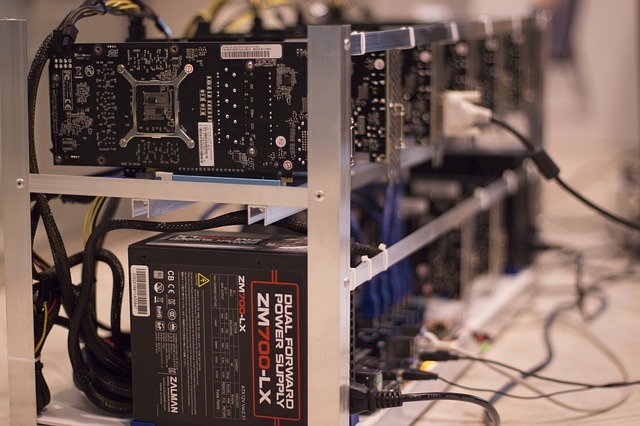If you know where I was going with that, thank you. I always wondered if Dunder Mifflin was a lifelong OTC company. Now for the reason you are here. In this article, I have made a top penny stocks list for the first week of April.
Each of these sections will include a detailed report of their achievements, plans, and challenges. This top penny stocks list starts with a new player in the emerging blockchain space. Next, is a leading cannabis producer with a vertical business map. Then, I cover a durable medical equipment producer. The fourth company covered has had a long journey to producing a cancer cure. Last, is a lithium miner renewing the way this mineral is collected. Please feel free to comment any other stocks you would like me to cover as well as any thoughts and opinions!
1. Hive Blockchain Technologies (HVBTF)
Mission: Mining Sustainably and Creating Long-Term Value
Hive Blockchain is aiming to accelerate the rise of the blockchain sector. With the help of some experienced leaders, the company has grown to multiple locations. In Canada, Sweden, and Iceland, Hive has focused on creating mining data centers that run purely on renewable energy. The company chose to be in regions that reach a max temperature of 20 degrees C(68 F) during their warmest months. By doing this, HIVE is able to build a foundation that is based on “sustainability”. This term being one of the most common criticisms that blockchain miners face. Here is a video that highlights this decision.
An additional challenge that many blockchain miners face is the fact that they are inherently not profitable ventures. The excessive amounts of power required, and the consistent maintenance costs are a main issue. Then there’s the low probability of successfully mining a crypto(in the ballpark of 1-in-a-million per miner). So, it’s understandable why most ventures are playing a losing game. However, HIVE aims to minimize the input power/maintenance costs, and purchase a large amount of highly efficient miners. The last step is for cryptocurrency prices to continue to skyrocket. If all of this can occur, then profitability may not be such a pipe dream. We will just have to see about all of that though.
Sizing up its Competitors
Riot Blockchain and Marathon Patent Group are a couple of the largest crypto mining leaders. Both dwarf the size of HIVE. Currently, MARA and RIOT are trading at a market cap of $4.8B and $4.4B, respectively. Meanwhile, HIVE claims a market cap of $1.4B. Much of this has to do with the difference in quantity and quality of miners owned by each company. HIVE’s interest in Ethereum over BTC is one way that it differs from its peers. While most crypto mining companies purely focus on BTC, HIVE has built both Ethereum and BTC holdings. Surprisingly, a majority of their crypto holdings are in ETH. In their Investor Presentation, they share many of their thoughts on the differences between the two heavyweight currencies. The comparable performance of these two currencies could offer both advantages and disadvantages to HIVE’s overall valuation.
As we move on, it would be wise to focus on HIVE’s ability to control a low cost structure that thrives on a sustainable platform.
Price at publication: $3.98
2. 4Front Ventures (FFNTF)
Goal: Next-Generation Cannabis Company – A Decade in the Making
To nobody’s surprise, a cannabis company has found itself at the top penny stocks list once again.
Since it was founded in 2011, 4Front has been able to grow a “powerhouse” in the cannabis industry. They have done this by maximizing each segment of the value chain. 4Front has built a vertical business that is able to control all business processes. From this, they have found a market advantage in a business model founded on mass-produced, low-cost, quality cannabis products. They distribute a portfolio of over 25 cannabis brands through retail outlets and their own chain of “Mission” dispensaries. Noticeably, 4Front is working to put their focus on strategy execution and operational efficiencies.
Competitive Advantages
From a spectator’s viewpoint, much of the disinterest in recreational marijuana comes from the fact that “black market” purchases are far cheaper than going to a legitimate dispensary. This higher price is due to the fact that most recreational purchases are set at a premium and include an additional “sin tax”. Another issue that cannabis companies are having is the production inefficiencies that drive up costs. This is where 4Front aims to change the game. By streamlining the cultivation-to-sale process, 4Front aims to pump out products at highly-competitive price points. From this baseline efficiency operation, 4Front plans to rinse-and-repeat in each new state that legalizes the recreational sale of marijuana. To learn more about the company’s success and plans for the future, see their presentation at the bottom of this link.
Consumer Market Analysis Thoughts
The idea of a retail-based buying structure is something that has confused me lately. Many of the top legal sellers tout their huge compounds where customers purchase these products. Obviously, Amazon has led the world into an online business frenzy. So, why hasn’t the recreational marijuana market been able to do the same? The simple answer is strict regulation and compliance measures. Which is completely understandable. However, in the coming years of a Democrat-led US government, there seems to be more anticipation of nationwide legalization. Not to mention the growing debt that our government continues to build upon. A less restricted recreational market could lead to seismic gains in tax revenues for governments that need it. From here, only time will tell if companies like 4Front will have to/be able to comfortably transition to an e-commerce business model.
Overall, 4Front has done a great job winning market share in states like Washington that legalized marijuana early on. In Washington state, they have created a dominant position while maintaining respectable margins. These processes have already been replicated in 4 other states. From here, 4Front will look to continue winning market share and profits from its competitors.
Price at publication: $1.16
3. Protech Home Medical (now known as Quipt Home Medical) (QIPT)
Protech Home Medical aims to use technology to improve the home medical equipment industry. Within an industry that rarely sees innovation, Protech aims to offer products that are more beneficial to not only the patient, but the company’s processes as well. Led by a management team holding more than 60 years of relevant experience under its belt, they look to revitalize the market landscape. Here’s how.
A Patient Centric Business Model
Protech aims to leverage technology and strong distribution channels to streamline all phases of the durable medical equipment sales process. They are a premier provider of clinical respiratory equipment. Their business thrives from over 17,000 referring physicians across the eastern United States.
Although the company mainly focuses on respiratory equipment, they also offer mobility and sleep-aid products. By expanding these offerings, they plan to capture a larger share of this $84B market. Speaking of market size, a fun fact I found in their presentation, is that each day for the next 15 years, about 10,000 people will turn 65 years old. So, over the next two decades this addressable market will continue to expand. By continually expanding their technology capabilities, Protech looks to create an improved customer experience.
Bridging Technology with Elderly Patients
One of the most common issues with utilizing technology among the elderly is the fact that they don’t understand how to use it. Traditionally, this causes them to incur more hardships as they must travel and remember how to effectively use the equipment they are given. To help alleviate this issue, Protech has built Tele-Health into its offering. By doing this, they hope to increase patient compliance, and reduce improper equipment use.
Growth Through Acquisitions
So far, we’ve seen that Protech’s growth plans are based on a naturally growing target market while leading the technology transformation. However, perhaps their most important strategy is completing valuable acquisitions. In late 2020, the company was able to secure a $20M revolving credit facility. With this new liquidity, Protech has put itself in a position to continue to seamlessly enter new markets with each purchase. So far, they have completed seven different acquisitions.
To finish, this company has a tremendous leadership team. Many of the members on the management team and Board of Directors carry 20+ years of experience in related industries.
Price at publication: $7.40
4. Northwest Biotherapeutics (NWBO)
Northwest Bio is a clinical stage biotechnology company focused on the development of personalized cancer vaccines. These vaccines are designed to treat a range of solid tumor cancers. Their goal is to offer treatments that are more effective than the current status quo. Also, they aim to build products that do not carry all the side effects of chemotherapy drugs. Most of their patients are people who are on the verge of entering hospice. So, these patients are usually in late-stages of their cancer battles, with inoperable solid tumors. Now, let’s look a bit more in to their product line.
DCVax – A Personalized Immune Therapy for Cancer
To start, DCVax is a technology that utilizes the master cells of the immune system(dendritic cells). The activation of these cells helps to mobilize the entire immune system. Now, Northwest Bio offers two products. The first being DCVax-L and the other is DCVax-Direct. Unlike most cancer drugs, DCVax has achieved clinical benefits for over 80% of patients in clinical trial. This stomps their competition. Considering the fact that most cancer drugs bring benefits to 25-30% of patients. DCVax is personalized and targets the patient’s specific biomarkers found on the patient’s tumor. There is only a small difference between the two product lines. The “L” version is designed to help patients with tumors that can be surgically removed. Meanwhile, the “Direct” version is designed for all solid tumors that are considered inoperable and cannot be removed. For a more in-depth understanding of these two products, I would reference this link.
Current Clinical Trials
This is where things get tricky. However, it is also where the most important inflection points in biotech companies occur. Northwest Bio has been running multiple clinical trials over the last two decades. Unfortunately, the problem with these trials is that they must wait a long amount of time to officially reveal results. Recently, a Phase III trial of DCVax-L for Gliobastoma (a type of brain cancer) was locked. This means that all necessary data has been collected and independent statisticians have access to the raw data. Some think that the trial taking so long could be hidden good news. The name of the game is to keep cancer patients alive longer. And these trials are built to determine if these treatments do just that. So, some people think the delayed conclusion could mean that the DCVax-L had a positive effect on these patients’ lifespans.
For now though, we must wait for the public announcement and scientific publication to be put forward.
Overall, this company is working tirelessly to introduce a new strategy of fighting cancer to the forefront of science. Whether they’ll be successful in doing that is still up for grabs. But, the Company’s cancer therapies have shown to extend both time to recurrence of tumors and survival. Although I never give investment advice, I will say that this is a company that everyone should cheer on.
Price at publication: $1.43
5. American Lithium Corp. (LIACF)
This company is engaged in the acquisition, exploration, and development of lithium resources throughout the Americas. To start, as of December 2020, the company was 60% owned by management & directors. This usually is a positive point, assuming that those leading the company hold on to this ownership position throughout the development of the company. They currently are actively pursuing one project in the Nevada desert. The TLC Project, in Tonopah, NV looks to take advantage of this underdeveloped lithium basin. American Lithium claims that with their minerology process, they can produce battery-grade lithium within a few hours. Additionally, their preliminary results show that 90% of the lithium can be removed from the surrounding claystone within 10 minutes. More on this below.
As of now, American Lithium is working on creating a pilot plant to be prepared in Q2 of 2021(aka now). The purpose of this pilot is to prove the low-cost production process. By having a low-cost process that produces high yields of lithium, the Company hopes to win grants from the federal government. All-in-all, company leadership believes that the combination of a short processing time and high-yielding output, will lead to a highly-scalable project if everything goes as planned. One question that still remains is exactly how much of that 6,000 acre basin is littered with lithium deposits? That is something that may be released in the coming months.
Lithium Supply & Demand
As we all know, lithium demand has seen a speculative increase over the past few months. The slow but steady migration to electric vehicles and lithium-ion batteries continues to lurch forward. By “lurch forward”, I mean that the global demand has increased by 20%, 12%, and 4% over the last 3 years, respectively. (This can be found on Page 23 from the “Download Presentation” link on their home page.) However, with nearly every large automobile manufacturer presenting their upcoming “groundbreaking” EV, it’s hard to believe this downtrend will hold much longer. Moreover, lithium can be found in cell phones, notebook laptops, renewable energy materials, and robotics. These are all industries that expect to see growth in the near future.
Lastly, USA News Group released a report that discussed how liquid lithium could have a massive impact on future energy production. The idea being that nuclear fusion reactors could use the material to control the extreme heat created during the process. However, this is another speculative demand raise for lithium in the coming years.
Now for the supply. Currently, two countries are responsible for 95% of North America’s Lithium Imports. Those two countries being Argentina and Chile. Recently, lithium was listed among 35 of the “critical minerals” in the American Minerals Security Act. The US Government believes it will be crucial to develop local supplies of these minerals to secure our “minerals independence.” Finally, in 2020, the global lithium supply decreased by 18% in 2020. If demand begins to rise, and supply remains low, many lithium producing companies may be find themselves in potentially profitable situations.
Acquisition & Year Long Plans
In February of 2021, American Lithium acquired Plateau Energy. This company operates a lithium production project in Peru, called Falchani. Also, they have a current project called Macusani which mines uranium. This project is also located in Peru. In American Lithium’s most recent presentation, they share some of the benefits this acquisition offers to shareholders. Providing geographic diversity, increasing the lithium resource base, and the addition of key executives were some of the benefits listed. These executives add significant expertise in lithium extraction and metallurgy. It will be interesting to see how American Lithium looks to align these three operations. Nonetheless,the company touts that this move establishes their “position as a leading consolidator of lithium development assets.
In the coming months, there will likely be many more announcements for this small, growing company. (They recently hired a marketing company to help out from this aspect.) Although it is a highly speculative company, so is every other new mining company out there.
Price at publication: $1.95
Top Penny Stocks List Summary
Much like last week’s report, many of these companies find themselves in highly speculated markets. This top penny stocks list has many companies offering groundbreaking ideas. Although many are still in their early growth phases, some have faced many challenges that may be difficult to overcome.
If you haven’t been able to browse my website, follow the following link to the Start Here page. In the upcoming weeks, I plan to include some of my favorite resources and courses I have enjoyed learning from in the past. Last, if anyone has any suggestions, questions, or concerns please feel free to reach out to me through the link provided here. Come back next week for another top penny stocks list.
*Disclaimer: The opinions expressed in the Blog are for general informational purposes only and are not intended to provide specific advice or recommendations for any individual or on any specific security or investment product. It is only intended to provide education about the financial industry.






